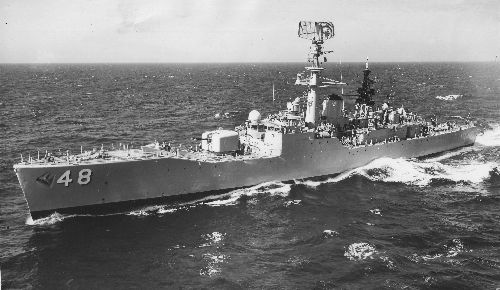- Author
- Smith, John, Cmdr, RAN (RTD)
- Subjects
- Ship design and development
- Tags
-
- RAN Ships
- HMAS Derwent, HMAS Swan II, HMAS Parramatta III, HMAS Torrens II, HMAS Stuart III, HMAS Yarra III
- Publication
- June 2008 edition of the Naval Historical Review (all rights reserved)
The December 2007 edition of the Naval Historical Review contained a brief history of the RAN River Class Frigates. It also referred to the major differences between the six ships of the class. The most obvious initial variations were in Swan and Torrens. Why was this?
In 1964, I was a lowly staff officer in the Directorate of Tactics and Staff Requirements in Navy Office, Canberra. I was unaware of their relevance at the time, but the following documents, amongst thousands of others, were held in Navy Office.
- a) RN staff requirements for their then new escorts, some of which were to be helicopter compatible and, therefore, were to have stabilisers incorporated
- b) A report by the Director of Scientific Services (Navy) on the LW02 long range air warning radar and the medium range sonar type 177 in the early ships of the class which emphasised the degradation in performance of both sensors by their movement in most seaways as these sensors were not stabilised.
- c) Detailed reports by the commissioning Captains of Parramatta and Yarra which had a plethora of constructive suggestions for any follow-on ships.
- d) A report by the Director of Electrical Engineering, again relating to the early ships of the class, stressing the large power loss in the waveguides to the LW02 radar aerials because they were mounted so high in the ships, i.e. on top of the foremast.
Then came the tragic Melbourne and Voyager collision. An initial reaction of the Government was to approve the acceptance of the offer by the Royal Navy of the loan of HMS Duchess.
However, if we go back briefly to August 1950, the then Government had announced that ‘six new fast anti-submarine frigates were to be laid down to cost two million pounds each, three to be built at Cockatoo Island Dockyard, Sydney and three at the Naval Dockyard, Williamstown; but only four are to be proceeded with, two at each yard’.
The four approved were Yarra, Parramatta, Stuart and Derwent.
Someone with a sense of opportunity recalled the paper approval of the fifth and sixth frigates and, obviously with prompting by the naval staff, they were also approved after the Melbourne and Voyager collision, with the proviso that they be exactly the same as their predecessors.
My immediate boss, the Director of Tactics and Staff Requirements, who coincidentally had been the commissioning Captain of HMAS Parramatta and had been involved in writing one of the reports referred to earlier, came into our office on a Friday afternoon to inform us of the Government decision. He followed this up by telling his three staff officers, of whom I was one, that we were to produce reasons as to why the two new frigates should not be the same as their predecessors but should be much improved.

Starting with the reports mentioned earlier, we then encountered the next interesting aspect of our task. It was no longer possible to acquire most of the equipment fitted in the earlier frigates. For instance, the steam propulsion machinery now available had been substantially upgraded to our advantage.
In addition, the opportunity was taken to alter the hull slightly from the Whitby class type 12 to the Leander class hull which, amongst other things, was slightly larger.
To overcome the lack of stabilisation of the two major sensors, the hull mounted stabilisers were installed. I spent a very uncomfortable half hour with the then Chief of Naval Staff trying to convince him that it was not a retrograde or unseamanlike step to install stabilisers in modern warships. Fortunately, in this case, I was able to show him that the Royal Navy was fitting them although I did not tell him that it was for a different reason to our requirement.
To overcome the loss of power in the waveguide transmission to the LW02 aerial, the aerial and its transmitter office were moved much further aft and the aerial was lowered significantly. This apparently resulted not only a reduction in top weight, but also an improvement in detection performance.
A very obvious change in appearance resulted from the choice of gunnery fire control system. The four earlier ships were fitted with the Royal Navy’s MRS3 Mod 1 system which had some limitations in performance and reliability. Perhaps fortuitously, it was no longer being manufactured. Its successor in the Royal Navy was the MRS 3 Mod 3 which was still under development. The information we held at that stage indicated that the Mod 3 was heavier (because of the nuclear protection of the director’s crew) and required more space between decks.




